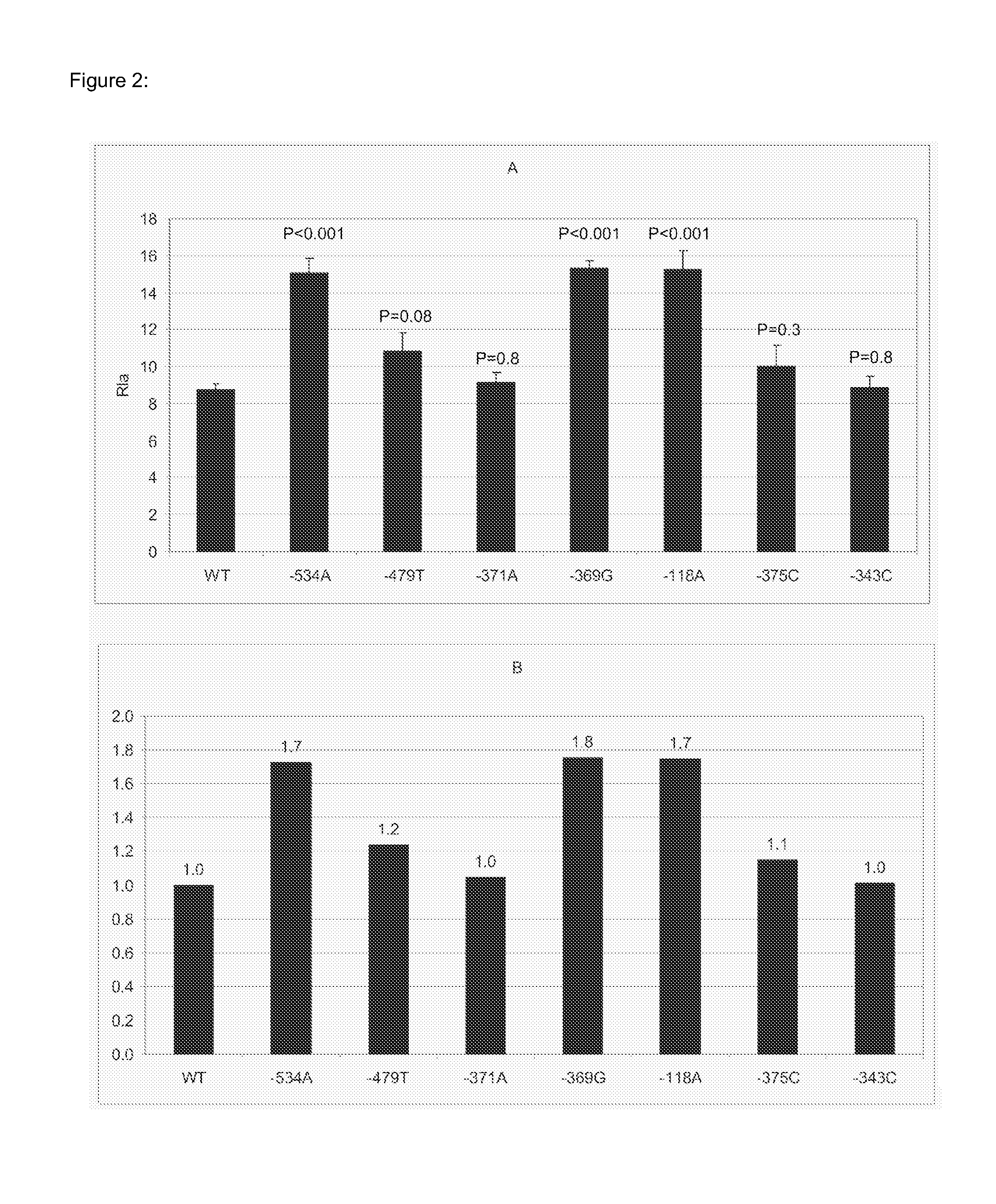Promoter mutations that increase amyloid precursor protein expression
a technology of amyloid precursor protein and promoter region, which is applied in the direction of sugar derivatives, biochemistry apparatus and processes, animal husbandry, etc., can solve the problems that the influence of app transcriptional activity might also contribute to disease risk, and there are no alzheimer disease-related mutations
- Summary
- Abstract
- Description
- Claims
- Application Information
AI Technical Summary
Benefits of technology
Problems solved by technology
Method used
Image
Examples
example 1
Variation in the 5′ Regulatory Region of APP
[0027]We sequenced the −766 / +204 region of the proximal APP promoter and exon 1, and two more distal promoter regions −2634 / −2159 and −2096 / −1563, in two independently ascertained Dutch-speaking early-onset AD groups composed of 180 Belgian and 111 Dutch patients (Table 1). In total, we identified nine heterozygous sequence variants and confirmed their presence in the respective carriers by a second method, i.e., PCR-RFLP analysis or pyrosequencing (Table 3—Quandt et al., 1995; Brouwers et al., 2006). Analysis in 450 age- and gender-matched healthy control individuals (180 Belgian and 270 Dutch individuals) demonstrated that three variants (33%) were known polymorphisms: −2335C / T (rs364091), −1901G / T (rs1235879) and +37G / C (rs459543) (Table 3A), the latter being the same one reported by Athan et al., (2002). Also, in agreement with this study, the −9G>C variant was not observed in the AD patients. Six of nine variations (67%) were present ...
example 2
Transcriptional Activity of APP Promoter Mutations
[0033]We cloned the −766 / +204 APP promoter fragment containing wild-type (WT), or mutant −534A, −479T, −371A, −369G, or −118A alleles into the pGL3basic vector upstream of a firefly luciferase reporter gene. As controls, we used the −375C and −343C alleles, identified in control individuals. Reporter gene assay of transiently transfected human embryonic kidney (HEK293) cells showed no significant differences in expression level between −534A, −479T, −371A, −369G, and −118A and WT promoter sequences. Also, real-time PCR APP mRNA quantification in lymphoblasts from the mutation carriers (N=2) did not reveal significant differences in expression levels compared to control individuals. However, in human neuroblastoma (SH-SY5Y) cells, a significant near two-fold increase (p-value<0.001) in APP transcriptional activity was observed for three of the five mutant alleles identified in early-onset AD patients: −534A, −369G and −118A (FIG. 2). ...
example 3
Allele-Specific Transcription Factor Binding
[0035]We examined whether the three mutant alleles affecting APP expression (−118C / A, −369C / G, −534G / A) interfered with the specific recognition of the APP promoter by nuclear factors extracted from SH-SY5Y cells using electrophoretic mobility shift assays (EMSA). We used 31 bp long double-stranded oligomers containing one of six possible promoter alleles. We observed that SH-SY5Y nuclear extracts contained nuclear proteins binding specifically to all three regions of the APP promoter, resulting in the formation of one or two major complexes (FIG. 3). Competition with 50-fold excess of the respective unlabeled oligomers resulted in complete inhibition of complex formation. For −118C / A, one major complex bound to both alleles, however, with a higher binding affinity for the mutant A-allele. The major complex binding to the −369C / G probe showed a decrease in binding affinity or even a slight shift in complex mobility for the mutant G-allele....
PUM
| Property | Measurement | Unit |
|---|---|---|
| volume | aaaaa | aaaaa |
| volume | aaaaa | aaaaa |
| concentrations | aaaaa | aaaaa |
Abstract
Description
Claims
Application Information
 Login to View More
Login to View More - R&D
- Intellectual Property
- Life Sciences
- Materials
- Tech Scout
- Unparalleled Data Quality
- Higher Quality Content
- 60% Fewer Hallucinations
Browse by: Latest US Patents, China's latest patents, Technical Efficacy Thesaurus, Application Domain, Technology Topic, Popular Technical Reports.
© 2025 PatSnap. All rights reserved.Legal|Privacy policy|Modern Slavery Act Transparency Statement|Sitemap|About US| Contact US: help@patsnap.com



